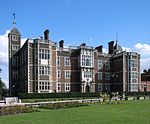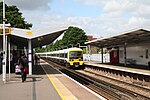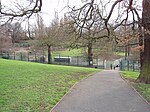Garden house at Charlton House
Buildings and structures in the Royal Borough of GreenwichCharlton, LondonGrade I listed buildings in the Royal Borough of Greenwich

The Garden house at Charlton House, in the Royal Borough of Greenwich, is a summer house dating from the 1630s. The structure is often attributed to Inigo Jones, though there is no documentary evidence to support this claim. Its original purpose is unknown. In the 20th century, the building functioned as a public lavatory and by the 21st had become derelict and was placed on Historic England's Heritage at Risk Register. As of 2022, the garden house is undergoing restoration. It is a Grade I listed building.
Excerpt from the Wikipedia article Garden house at Charlton House (License: CC BY-SA 3.0, Authors, Images).Garden house at Charlton House
The Village, London Charlton (Royal Borough of Greenwich)
Geographical coordinates (GPS) Address Nearby Places Show on map
Geographical coordinates (GPS)
| Latitude | Longitude |
|---|---|
| N 51.4812 ° | E 0.0361 ° |
Address
Charlton House Gardens
The Village
SE7 8UF London, Charlton (Royal Borough of Greenwich)
England, United Kingdom
Open on Google Maps









